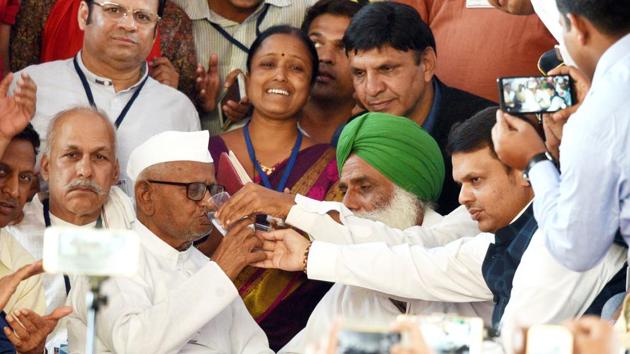The narrative around 2019 is more likely to be shaped from state capitals than Ramlila Maidan
Special status in one state, farm loan waiver in another could dominate the agenda in specific states. This will also increase the importance of caste and community equations.
Anna Hazare sat on a hunger strike in Delhi’s Ramlila Maidan to press for demands, including the appointment of Lokpal and Lokayukta. The agitation has not had any impact on the current political environment. Mass-participation is a minuscule fraction of what it was when Anna came to Delhi in 2011. The 2011 Lokpal agitation marked the beginning of the end of the Congress-led United Progressive Alliance (UPA). What explains the subdued response now?

Conspiracy theorists will attribute this to the absence of tacit support by forces which had a vested interest in discrediting the Congress in 2011. Such views are oblivious to how political-economy narratives work. The political-economy path to 2019 is likely to be very different from 2014.
Was the mass support for the Lokpal movement in 2011 a reflection of a nuanced understanding of the details of the proposed Lokpal bill? It is extremely unlikely. Multiple factors contributed to the momentum behind the agitation.
The UPA government was already embroiled in corruption scandals before the Lokpal agitation started. Corruption was not the only problem. Inflation had grown at more than 10% in 2009-10 and 2010-11. Economic growth had started decelerating since 2011-12. Rising prices and slowing growth meant real economic pain for the masses. This was a drastic reversal from the boom phase during the UPA I period.
Why did this economic reversal happen? A complex set of economic factors were at play. The global economic crisis generated headwinds for export earnings. Oil prices had started rising. Revenue projections did not materialise due to slowing down of growth, which constrained the government’s ability to spend more money in the economy. Governments gain when there are external factors helping the economy. They lose when the cycle turns.
Allegations of corruption along with the worsening economic situation created an ominous situation for the UPA. All the economic hardships in the latter half of UPA-II’s tenure were attributed to the alleged corruption within the government. This was a much more palatable narrative than cyclical factors bringing down growth. That the Congress behaved in an arrogant way and went wrong with its political messaging only strengthened this view.
It was this narrative which the 2011 Lokpal agitation drew its mass support from. The BJP hitched on to the sentiment and went on to decimate the Congress.
Let us come back to what is happening now. As of now, no big corruption charge haunts this government. Bank frauds are growing by the day. But the relative autonomy of public sector banks will keep the government immune from direct anger. Unless there is compelling evidence to show that there was collusion to aid the accused. Even the Rafale procurement controversy is unlikely to inflict big damage. This could change if there are direct allegations of someone in the government receiving kickbacks. It took nothing less than an incumbent defence minister (V P Singh) coming out in rebellion to make the Bofors scam into a political issue against the Rajiv Gandhi government.
There are problems on the economic front. The revival in economic growth has been skewed. Real earnings in the agriculture sector have been stagnant under this government. Private investment activity is still not reviving. Export earnings are unlikely to show high growth, given the fears of US protectionism triggering trade wars. Policies such as demonetisation and GST have thrown a spanner in the wheels of the informal economy not once, but twice. However, both inflation and macroeconomic stability is still better than UPA II’s times.
Despondency, more than anger, seems to be the economic mood right now. Many believe that the promise of achhe ain has not materialised. But at the moment there is no compelling anti-BJP economic narrative which will snowball as the 2019 general elections near. We should remember that the BJP managed to win Uttar Pradesh and Gujarat in the immediate aftermath of demonetisation and GST. Rural distress is beginning to haunt the BJP, but whether it will bring the party down is a question which is difficult to answer right now.
This might seem like good news for the BJP. However, it is not just the opposition which will not have a grand economic narrative for 2019. In 2014, the BJP campaign sold Narendra Modi as someone who could drastically change India’s fortunes by replicating his Gujarat model at the Centre in 2014. That halo is unlikely to remain the same in the next elections because of the current economic situation.
This might make local issues more germane to political outcomes. Special status in one state, farm loan waiver in another could dominate the agenda in specific states. This will also increase the importance of caste and community equations. The narrative around 2019 is more likely to be shaped from state capitals than Ramlila Maidan. It will only make it more difficult to read the trends.






